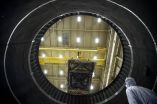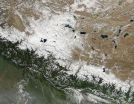(Press-News.org) After 116 days of being subjected to extremely frigid temperatures like that in space, the heart of the James Webb Space Telescope, the Integrated Science Instrument Module (ISIM) and its sensitive instruments, emerged unscathed from the thermal vacuum chamber at NASA's Goddard Space Flight Center in Greenbelt, Maryland.
Teams of engineers and technicians have been on heart-monitoring duty around the clock since this complicated assembly was lowered into the chamber for its summer-long test.
Engineer Mike Drury, the ISIM Lead Integration and Test Engineer, is one of the test directors making sure that Webb will thrive in the frigid conditions at its final destination in space one million miles away from Earth. "The telescope is going to L2 or Lagrange Point 2, which is a very extreme environment," said Drury. "The heart of Webb called ISIM is a very important part of the observatory and will provide all of Webb's images."
These images will reveal the first galaxies forming 13.5 billion years ago. The telescope will also pierce through interstellar dust clouds to capture stars and planets forming in our own galaxy. Operating a telescope powerful enough to complete these tasks requires incredibly cold temperatures.
How cold? Try -387 degrees Fahrenheit, or 40 degrees Kelvin. This is 260 degrees Fahrenheit colder than any place on the Earth's surface has ever been. To create temperatures that cold on Earth, the team uses the massive thermal vacuum chamber at Goddard called the Space Environment Simulator, or SES, that duplicates the vacuum and extreme temperatures of space. This 40-foot-tall, 27-foot-diameter cylindrical chamber eliminates the tiniest trace of air with vacuum pumps and uses liquid nitrogen and even colder liquid helium to drop the temperature simulating the space environment.
"We complete these tests to make sure that when this telescope cools down, the four parts of the heart are still positioned meticulously so that when light enters the telescope we capture it the right way," said Paul Geithner, Webb's deputy project manger. "The biggest stress for this telescope will be when it cools down. When the telescope structure goes from room temperature to its super cold operating temperature, it will see more stress from shrinkage than it will from violent vibration during launch," said Geithner.
NASA photographer Desiree Stover captured the photo of ISIM as it was lowered into the chamber for testing. The heart of the telescope weighs about as much as an elephant. Inside its black composite frame the four science instruments are tightly packed and are specially designed to capture specific information about distant light in the universe.
"When I first started here at Goddard, the ISIM structure was completely bare," said Stover who has been at Goddard for two years. "Leading up to this test all four science instruments were integrated onto it, along with heat straps, harnesses and blankets."
Tightening the bolts and putting everything together beforehand required very dedicated teams. "When ISIM was lowered into the chamber at the start of the test, that was a pretty emotional moment that represented an intense amount of work," said Marc Sansebastian, a mechanical assembly, integration and test technician. "After ISIM traveled overhead, we shifted back to technical mode because there are a million things that happen that you don't see."
At any given time of day during the test, the control room held representatives from all four-instrument teams. Each instrument has a test engineer, who makes sure the test is going well, and a data analyzer. Those teams are testing the hundreds of electrical connections and computer programs that give life to Webb's heart. "Kind of like having a car in a garage in the winter. You want to check the car to make sure that it is still working," said Alistair Glasse, instrument scientist for the Mid-Infrared Instrument (MIRI).
"The weather this year was phenomenal for the test. When the weather is bad, when it's humid and when it gets stormy that's when we run into problems with the chamber," said Ray Lundquist, ISIM Lead Systems Engineer. "At the beginning of the test, we had a couple of storms and the building got hit by lightning that shut the whole system down for 30 minutes, but since that storm we have had really great weather."
Once the test was completed, the team warmed up the chamber, and completed the final functional test and a series of data analyses before they opened up the chamber.
"We've been very fortunate on this test. We've worked with all of the different teams. We have all been working shifts and pitching in," said Drury. "I'm really amazed at how well everyone is getting along together. We have a lot of people who are willing to help out."
INFORMATION:
The James Webb Space Telescope is the scientific successor to NASA's Hubble Space Telescope. It will be the most powerful space telescope ever built. Webb is an international project led by NASA with its partners, the European Space Agency and the Canadian Space Agency.
Learn more about the Webb telescope at:
http://www.jwst.nasa.gov -- or -- http://www.nasa.gov/webb
College Park, Md. - The supply chain is ground zero for several recent cyber breaches. Hackers, for example, prey on vendors that have remote access to a larger company's global IT systems, software and networks.
In the 2013 Target breach, the attacker infiltrated a vulnerable link: a refrigeration system supplier connected to the retailer's IT system.
A counter-measure, via a user-ready online portal, has been developed by researchers in the Supply Chain Management Center at the University of Maryland's Robert H. Smith School of Business.
The portal is based on ...
Question: When does a Tropical Cyclone drop snowfall?
Answer: When it makes landfall in India and the moisture moves over the Himalayas as Cyclone Hudhud has done. When NASA's Aqua satellite passed over the Himalayan Mountains, the MODIS instrument captured this image of snow on the ground on Oct. 16 at 0705 UTC (3:50 a.m. EDT). Cyclone Hudhud made landfall in eastern India and moved over the Himalayas dropping snowfall in Nepal and southwestern China.
INFORMATION:
Rob Gutro
NASA's Goddard Space Flight Center
...
Substance abuse is the fastest growing health concern for older adults.
New findings show that drinking levels are high enough to be concerning and tend to spike around the times older adults receive their social security checks.
These results may have prevention implications for social workers working with low-income seniors.
Substance abuse is the fastest growing health concern for older adults, a segment of the population that is likewise rapidly increasing. Heavy drinking among older persons is associated with an increased risk of health problems like diabetes, ...
Most women reduce or stop drinking alcohol upon discovery of pregnancy.
A new study looks at changes in alcohol use, and factors contributing to these changes, among women with unwanted pregnancies.
Findings indicate that most women with unwanted pregnancies quit or reduce alcohol consumption once they discover their pregnancies, and that some may be substituting alcohol for drugs once they discover their pregnancies.
Most women reduce or stop drinking alcohol upon discovery of pregnancy. However, little information exists about changes in alcohol use, and factors ...
Mexico is a nearby destination where younger U.S. residents can legally drink heavily.
However, high levels of drinking on the U.S. side are not always linked to recent travel to Mexico.
New findings show that higher levels of drinking among U.S.-Mexico border youth are closely linked to their patterns of bar attendance, but not to how they think about drinking.
Due to a legal drinking age of 18 years, cheaper alcohol, and marketing tactics of local bars that specifically target youth, Mexico is an attractive and geographically nearby destination where younger U.S. ...
Researchers know that alcohol-dependent individuals (ALC) sustain neurocognitive impairment even after detoxification.
A new study examines specific domains of cognitive recovery in conjunction with smoking status.
Findings show that smoking status influenced the rate and level of neurocognitive recovery during eight months of abstinence in the ALC group.
Numerous studies have shown that individuals with an alcohol use disorder perform worse than those without one on multiple neurocognitive domains of function following detoxification from alcohol, although the level ...
Boston, MA — Switching from nonprofit to for-profit status appears to boost hospitals' financial health but does not appear to lower the quality of care they provide or reduce the proportion of poor or minority patients receiving care, according to a new study from Harvard School of Public Health (HSPH) and Brigham and Women's Hospital.
"Critics of for-profit hospitals have argued that they are worse at providing good care to patients and that therefore we should limit them," said Ashish Jha, professor of health policy and management at HSPH and senior author of ...
Medical practices in less competitive health-care markets charge more for services, according to a study conducted by researchers at the Stanford University School of Medicine and the National Bureau of Economic Research.
The study, based on U.S. health-care data from 2010, provides important new information about the effects of competition on prices for office visits paid by preferred provider organizations, known more commonly as PPOs. PPOs are the most common type of health insurance plan held by privately insured people in the United States.
The study will be ...
Searching a health service pricing website before using the service was associated with lower payments for clinical services such as advanced imaging and laboratory tests, according to a study in the October 22/29 issue of JAMA.
Recent changes in the health care insurance market have resulted in commercially insured patients bearing a greater proportion of their health care costs. As patients have an increasing responsibility to pay for their care, they will likely demand access to prices charged for that care. Several state-administered initiatives have increased price ...
Hospital conversion from nonprofit to for-profit status in the 2000s was associated with better subsequent financial health but had no relationship to the quality of care delivered, mortality rates, or the proportion of poor or minority patients receiving care, according to a study in the October 22/29 issue of JAMA.
During the past decade, there has been increasing attention to the growing number of nonprofit or public hospitals that have become for-profit. These conversions are controversial. Advocates argue that for-profit organizations bring needed resources and experienced ...

